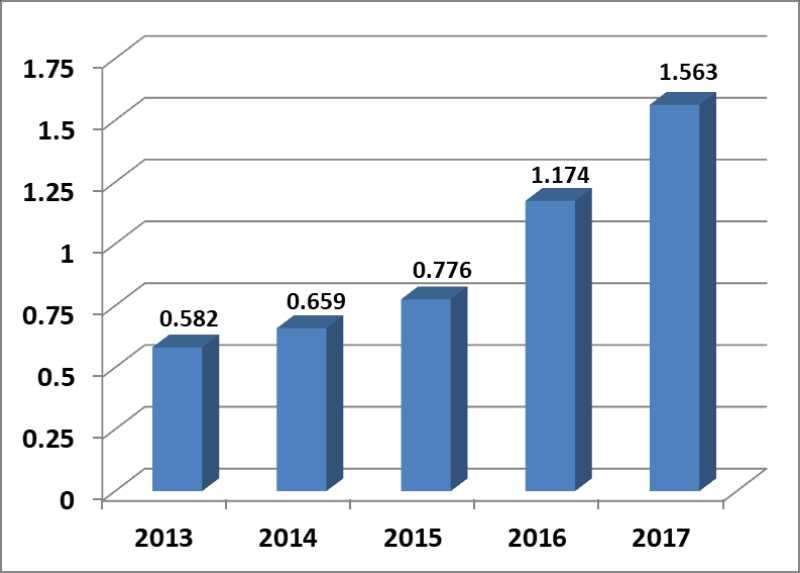CONTENTS
ARTICLES
Determination of epsilon for Omega vortex identification method
Xiang-rui Dong(董祥瑞), Yi-qian Wang(王义乾), Xiao-ping Chen(陈小平), Yinlin Dong,Yu-ning Zhang(张宇宁), Chaoqun Liu(541)
Transient curvilinear-coordinate based fully nonlinear model for wave propagation and interactions with curved boundaries
Yu-Hsiang Chen, Keh-Han Wang(549)
Tracer advection in a pair of adjacent side-wall cavities, and in a rectangular channel containing two groynes in series
Mohammad Mahdi Jalali, Alistair G. L. Borthwick(564)
Numerical simulation of transient turbulent cavitating flows with special emphasis on shock wave dynamics considering the water/vapor compressibility
Chang-chang Wang (王畅畅), Biao Huang (黄彪), Guo-yu Wang (王国玉), Zhong-ping Duan (段忠平),Bin Ji (季斌)
On the nonlinear transformation of breaking and non-breaking waves induced by a weakly submerged shelf
Giorgio Contento, Guido Lupieri, Thomas Puzzer(592)
Investigation of the hydrodynamic performance of crablike robot swimming leg
Li-quan Wang (王立权), Hai-long Wang (王海龙), Gang Wang (王刚), Xi Chen (陈曦), Asker Khan,Li-xing Jin (靳励行)(605)
A well-balanced positivity preserving two-dimensional shallow flow model with wetting and drying fronts over irregular topography
Gang-feng Wu (吴钢锋), Zhi-guo He (贺治国), Liang Zhao (赵亮), Guo-hua Liu (刘国华)(618)
Navigable flow condition simulation based on two-dimensional hydrodynamic parallel model
Shang-hong Zhang (张尚弘), Yu Wu (吴昱), Zhu Jing (荆柱), Yu-jun Yi (易雨君)(632)
Experimental and numerical investigations of the aerodynamic noise reduction of automotive side view mirrors
Xin Chen (陈鑫), Shuo Wang (汪硕), Yuan-qiang Wu (吴元强), Yan-yang Li (李延洋), Huai-yu Wang (王怀玉)(642)
Dominant factor and incremental depth formula for self-aerated flow in open channel
Rui-di Bai (白瑞迪), Fa-xing Zhang (张法星), Wei Wang (王韦), Shanjun LIU (刘善均)(651)
Scale adaptive simulation of vortex structures past a square cylinder
Javad Aminian(657)
The effects of the rotor-stator interaction on unsteady pressure pulsation and radial force in a centrifugal pump
Issa Chalghoum , Sami Elaoud , Hatem Kanfoudi , Mohsen Akrout(672)
Numerical and experimental investigation of three-dimensionality in the dam-break flow against a vertical wall
Mohamed M. Kamra, Nik Mohd, Cheng Liu, Makoto Sueyoshi, Changhong Hu(682)
Comparison of hydrodynamic influence between different types of bay reclamations
Xue-feng Xu (许雪峰), Qi-qi He (何齐齐), Dan Song (宋丹), Zhong-liang Yang (杨忠良), Liang-liang Yu (俞亮亮)(694)
Transient temperature and pressure calculation model of a wellbore for dual gradient drilling
Xue-rui Wang (王雪瑞), Bao-jiang Sun (孙宝江), Ping-ya Luo (罗平亚), Zhi-yuan Wang (王志远),Ning Wang (王宁), Ke Ke (柯珂), Hui Zhang (张辉)(701)
Transient air-water flow patterns in the vent tube in hydropower tailrace system simulated by 1-D-3-D coupling method
Xi-chen Wang (王希晨), Jian Zhang (张健), Xiao-dong Yu (俞晓东), Sheng Chen (陈胜)(715)
Finite element analysis of nitric oxide (NO) transport in system of permeable capillary and tissue
Ya-jie Wei (魏雅洁), Ying He (贺缨), Yuan-liang Tang (唐元梁), Li-zhong Mu (母立众)(722)
Effects of Froude number and geometry on water entry of a 2-D ellipse
Xu Zhang (张旭), Pei-qing Liu (刘沛清), Qiu-lin Qu (屈秋林), Rui Wang (王睿), Ramesh K. Agarwal(738)
LETTERS
Large eddy simulation of tip leakage cavitating flow focusing on cavitation-vortex interaction with Cartesian cut-cell mesh method
Xiao-rui Bai白晓蕊), Huai-yu Cheng (程怀玉), Bin Ji (季斌), Xin-ping Long (龙新平)(750)
Roughness height of submerged vegetation in flow based on spatial structure
Wei-jie Wang (王伟杰), Wen-qi Peng (彭文启), Wen-xin Huai (槐文信), Xiao-dong Qu (渠晓东),Fei Dong (董飞), Jian Feng (冯健)(754)
Non-invasive image processing method to map the spatiotemporal evolution of solute concentration in two-dimensional porous media
Jia-zhong Qian (钱家忠), Ze-kun Wang (王泽坤), R. M. Garrard , Yong Zhang, Lei Ma (马雷)(758)
INTERNATIONAL ACADEMIC EXCHANGE
2nd International Conference on the Material Point Method for Modelling Soil-Water-Structure Interaction
(762)
Call For Papers < The 3rd International Symposium of Cavitation and Multiphase Flow >
(764)
Editorial Message
(766)



